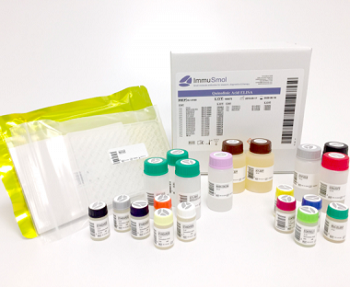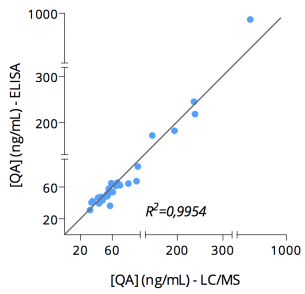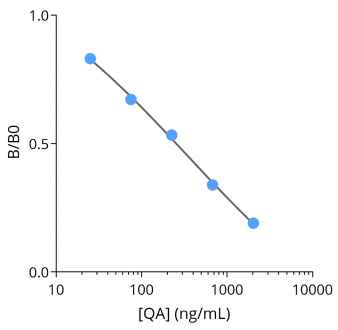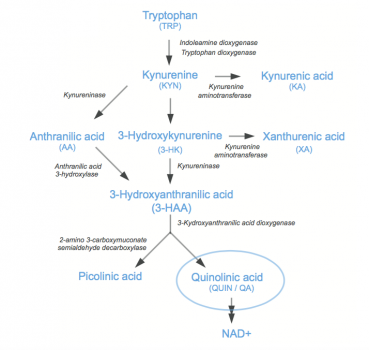Quinolinic acid ELISA kit
본문
|
Quinolinic acid ELISA kit
Quinolinic acid (QA) is a metabolite produced along the Kynurenine Pathway, which converts the aminoacid Tryptophan to NAD+, a co-factor of many enzymatic reactions.
The Quinolinic Acid ELISA kit is optimized for the quantitation of Quinolinic Acid (QUIN or QA) within serum and plasma samples. This easy-to-use competitive assay is well-suited for both small and large series of samples. Working with a low sample volume of 25µL, this assay enables pre-clinical and clinical sample testings.
Cross-validation of Quinolinic Acid ELISA and LC/MS data in human serum samples Human serum samples (n=28) were processed for Quinolinic Acid measurement by mean of both QA ELISA kit and liquid chromatography–mass spectrometry (LC/MS). As depicted, results obtained with ELISA and LC/MS are highly correlated (R Squared=0,9954).
Typical standard curve of Quinolinic acid ELISA Example of standard curve obtained with the QA ELISA Kit. In this competitive ELISA, optical density is invertly correlated with Quinolinic Acid levels.
Specifications
Quinolinic acid (QA) is a metabolite produced along the Kynurenine Pathway Quinolinic acid (QA) is a metabolite produced along the Kynurenine Pathway, which converts the aminoacid Tryptophan to NAD+, a co-factor of many enzymatic reactions. It has been described to share several neurotoxic functions particularly through the activation of the N-Methyl-D-Aspartate receptor. Its production occurring in myeloid cells (macrophages, microglia, etc.) is mainly driven by in ammatory stress and is therefore suspected to play a key role in neuroin ammatory disorders such as Alzheimer and Parkinson diseases but also Multiple Sclerosis, Amyotrophic Lateral Scle- rosis. Hence, while QA has been proposed as a biomarker in these indications, it might certainly warrant further investigation to serve as a surro- gate in other “in ammation” related diseases such as cancer, metabolic disorders, etc.
Instruction sheet (PDF)
References;
|
Ordering information
|
Catalog No. |
Product Name |
Size |
|
IS-I-0100 |
Quinolinic Acid ELISA kit |
96 wells plate |
▣ 관련 페이지 ; ImmuSmol
댓글목록
등록된 댓글이 없습니다.



